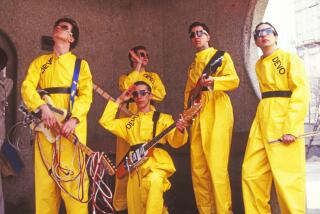Band Traces Its Beginnings to Van Nuys and Hard Rock of the ‘70s
- Share via
Georg Dolivo had left Van Nuys suddenly, had gone all the way back to Finland. The singer-guitarist was born there, even if he’d actually spent most of his life in the San Fernando Valley, in its schools and bars, stumbling through an early rock ‘n’ roll career that hadn’t actually gone anywhere.
The same sort of frustration soon led his friend, guitarist Greg Fields, to follow Dolivo to Europe with little more than the tapes of heavy rock he’d been making back home. But the energized collaboration that then emerged in Helsinki was something new for them, nothing like Dolivo’s last band, which he said “wasn’t so much a band as an excuse to drink beer.”
That was back in spring of 1987, and by the time they were both back in Los Angeles later that summer, the duo were making some “honest three-chords working-class rock” as a band that would ultimately call itself Rhino Bucket.
A more refined version of the same driving rough-and-tumble sound appears on Rhino Bucket’s new “Get Used to It” album. Their sound comes from their years listening to the euphoric racket of AC/DC, Black Sabbath, Led Zeppelin, Cheap Trick and Kiss, among other hard-rock heroes from the 1970s.
“We’re not trying to break any musical barriers,” said Fields, sitting with Dolivo in their Van Nuys apartment. “We’re a rock ‘n’ roll band. It sounds ridiculous and maybe old hat, but we get out there and have a good time. . . To me, anyways, that’s worth a lot.”
Both guitarists were dressed casually in black jeans and T-shirts, relaxing with some beer and cigarettes after the band’s recent tour of Australia with hard-rock veterans Angel City. A poster of AC/DC guitarist Angus Young was tacked to one wall, above a shattered electric guitar, while life-size cardboard stand-ups of Madonna and Elvira flanked the room.
Since signing with Warner/Reprise Records in 1989, the band--which includes drummer Liam Jason, also of Van Nuys, and Philadelphia-born bassist Reeve Downes--has nonetheless kept its operation relatively low-budget. The regular months-long van tours across the country more resemble the old no-frills travels of punk act Black Flag than any of the plush bus trips taken by some other young hard rock acts.
It reflects an attitude that Dolivo said stems from the band’s humble roots in Van Nuys, where rehearsals still occur as often as six times a week.
“I think it comes from a working-class mentality,” Dolivo said. “If one of your best buddies is a roofer, you can’t really complain about being in the studio for four hours playing rock ‘n’ roll. He’ll give you a good punch. That really helps us out, that our friends are really honest with us and not into the entertainment thing.”
Dolivo and Fields had moved to central Hollywood just as Rhino Bucket was winning some attention from major record labels, but they ultimately returned to Van Nuys. “I got tired of having big crack addicts urinating under my window at night. And all my friends are here,” Dolivo said. “The mystique of Hollywood didn’t mean a single damn thing to us.”
Still, it was in Hollywood that Rhino Bucket had attracted its core local following, with appearances at such alternative venues as the Anticlub, Rajis and, most often, at the Coconut Teaszer. At first, Dolivo said, there was some reluctance from the clubs to book this unknown quartet of longhairs.
“At that time everybody was wearing paisley shirts, and we were a little bit too antA.,” he said. “We were just four guys in T-shirts who wanted to play music, three chords and a cloud of dust. ‘Why aren’t you guys playing some keg-party in the Valley?’ ”
After that first show at the Coconut Teaszer, where Rhino Bucket had managed to bring in a few people with some flyers, the band was invited back regularly. The group also played the weekly “No Bozo Jams” at the Whisky up Sunset Boulevard, when up to a dozen bands would play a night.
But it was a little club in the Valley, the now-defunct Metro of Canoga Park, that had first testedthis thing called Rhino Bucket. Some of the band’s first gigs were there, sometimes twice a week.
“You really learn about a band, and what’s going to work, on stage,” Dolivo said. “We must have played 30 or 40 gigs at the Metro before we ever set foot in the Coconut Teaszer.”
Fields added: “And that’s a rare thing in Los Angeles. If you’re just starting out it’s really hard to get gigs more than once or twice a month. There’s so many bands that you can’t play all the time.”
Even now, Dolivo said, the band plays together as much as possible, often falling into long jam sessions during sound checks. In the many months leading to work on Rhino Bucket’s third album late next year, the band hopes to spend much of its time on stage, including an expected Los Angeles show in December.
“We’re not a band that writes a lot of songs before an album,” he said. “We write 15, 20. But we spend an obscene amount of time working to make each one right. We may only use three chords, but when we go to that third chord it better be right.”
More to Read
The biggest entertainment stories
Get our big stories about Hollywood, film, television, music, arts, culture and more right in your inbox as soon as they publish.
You may occasionally receive promotional content from the Los Angeles Times.











